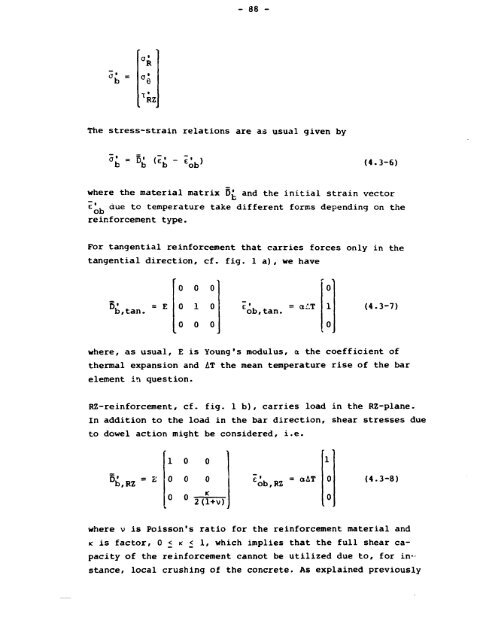Nonlinear Finite Element Analysis of Concrete Structures
Nonlinear Finite Element Analysis of Concrete Structures
Nonlinear Finite Element Analysis of Concrete Structures
Create successful ePaper yourself
Turn your PDF publications into a flip-book with our unique Google optimized e-Paper software.
- 86 -<br />
(4.3-6)<br />
where the material matrix Di and the initial strain vector<br />
e" due to temperature take different forms depending on the<br />
reinforcement type.<br />
For tangential reinforcement that carries forces only in the<br />
tangential direction, cf. fig. 1 a), we have<br />
0 0 0<br />
b,tan.<br />
0 1 0<br />
e' . = OLLT<br />
ob,tan.<br />
(4.3-7)<br />
0 0 0<br />
where, as usual, E is Young's modulus, a the coefficient <strong>of</strong><br />
thermal expansion and AT the mean temperature rise <strong>of</strong> the bar<br />
element in question.<br />
RZ-reinforcement, cf. fig. 1 b), carries load in the RZ-plane.<br />
In addition to the load in the bar direction, shear stresses due<br />
to dowel action might be considered, i.e.<br />
1 0<br />
0<br />
D b,RZ<br />
0 0<br />
0<br />
ob,RZ<br />
= aAT (4.3-8)<br />
0 0<br />
K<br />
2(l+v)<br />
where v is Poisson's ratio for the reinforcement material and<br />
K is factor, 0 < * < 1, which implies that the full shear capacity<br />
<strong>of</strong> the reinforcement cannot be utilized due to, for instance,<br />
local crushing <strong>of</strong> the concrete. As explained previously
















